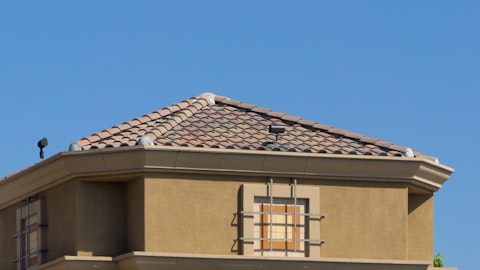M&T Bank Corporation (NYSE:MTB) Q1 2024 Earnings Call Transcript April 15, 2024
M&T Bank Corporation isn’t one of the 30 most popular stocks among hedge funds at the end of the third quarter (see the details here).
Operator: Good day, and welcome to the M&T Bank First Quarter 2024 Earnings Conference Call. All lines have been placed on listen-only mode and the floor will be opened for your questions following the presentation. [Operator Instructions] Please be advised that today’s conference is being recorded. I would now like to turn the hand — the conference over to Brian Klock, Head of Market and Investor Relations. Please go ahead.
Brian Klock: Thank you, Todd, and good morning. I’d like to thank everyone for participating in M&T’s first quarter 2024 earnings conference call, both by telephone and through the webcast. If you have not read the earnings release we issued this morning, you may access it along with the financial tables and schedules by going to our website, www.mtb.com. Once there, you can click on the Investor Relations link and then on the events and presentations link. Also, before we start, I’d like to mention that today’s presentation may contain forward-looking information. Cautionary statements about this information are included in today’s earnings release materials and in the investor presentation as well, and as well as our SEC filings and other investor materials.
The presentation also includes non-GAAP financial measures as identified in the earnings release and in investor presentation. The appropriate reconciliations to GAAP are included in the appendix. Joining me on the call this morning is M&T’s Senior Executive Vice President and CFO, Daryl Bible. Now I’d like to turn the call over to Daryl.
Daryl Bible: Thank you, Brian. And good morning, everyone. As you will hear today, our first quarter results were strong start for M&T Bank. Turning to Slide 3, we started the year with renewed and strengthened commitment to making a difference in people’s lives. Along with helping our customers meet their financial goals, we’ve continued to launch programs to uplift our communities and partners. Let me share with you a few examples of how we put these words into action. Since the beginning of the year, M&T has provided $900,000 to 30 organizations across our footprint to address affordable housing and homelessness in underserved, low to middle-income communities. We launched a new Spanish language small business accelerator program in Prince George’s County, Maryland, which will support many small business owners in the region.
We continue to invest in New England and Long Island through the second phase of our Amplify Fund. We do this when our communities are successful, so is our business. Turning to Slide 4, we are excited to see how deeply we embedded sustainability across the bank and into our products and services. We have included several sustainability accomplishments from our upcoming 2023 Sustainability Report and look forward to sharing more when we release the complete report this quarter. Turning to Slide 6, which shows the results for the first quarter. The quarter was highlighted by strong C&I and consumer loan growth. PPNR was a solid $891 million. Expense control remains a key focus and was evident as adjusted expenses increased only 0.6% compared to the first quarter of 2023.
Diluted GAAP earnings per share were $3.02 for the quarter. If we exclude the additional FDIC special assessment, adjusted diluted earnings per share were $3.15. On an adjusted basis, M&T’s first quarter results produced an ROA and ROCE of 1.05% and 8.49%, respectively. The CET1 ratio remains strong, growing to 11.07% at the end of the first quarter and tangible book-value share grew 1% to $99.54. Next, we walk a little deeper into the underlying trends that generated our first-quarter results. Please turn to Slide 8. Taxable-equivalent net interest income was $1.7 billion in the first quarter, down 2% from linked quarter. The net interest margin was 3.52%, down 9 basis points from the linked quarter. The primary drivers for the decrease to the margin were a negative 6 basis points from lower non-accrual interest and the impact of interest rate swaps, a negative 3 basis points from higher liquidity and cash moving into securities, negative 3 basis points from our deposit mix and pricing, and a positive 3 basis points from all other items, including the benefit of asset repricing in the investment portfolio and consumer loans.
Turning to Slide 9 to look at the average balance sheet trends. Average investment securities increased $1.1 billion to $28.6 billion, reflecting the reinvestment of maturing security balances and a measured shift of a portion of our cash balances into investment securities. Average interest-bearing deposits at the Fed increased approximately $0.5 billion to $30.7 billion as our decision to have more liquidity on the balance sheet was largely offset by the previously mentioned investment security purchases. Average loans increased $1 billion or 1% to $133.8 billion. Average deposits decreased $648 million or less than 1.5% to $164.1 billion. Turn to Slide 10 to talk about average loans. Average loans and leases increased 1% to $133.8 billion compared to the linked quarter.
Solid growth in C&I and consumer loans outpaced declines in CRE and residential mortgages. The growth in C&I loans was driven by combination of increased line utilization in our middle market and dealer business lines, combined with new origination activity in equipment finance, corporate and institutional, and fund banking as we continued to grow existing and new clients. Loan yields decrease 1% to 6.32%, but increased 2 basis points sequentially when excluding the impact of the cash flow hedges on interest income in our CRE portfolio. Within our consumer portfolio, we continue to see the benefit of higher rates on new originations compared to maturing balances. With the consumer loans yielding increased 12 basis points to 6.54%. Turning to Slide 11, our liquidity remains strong.
At the end of the first quarter, investment securities and cash, including cash held at the Fed totaled $62.3 billion, representing 29% of total assets. Average investment securities grew $1.1 billion, reflecting the reinvestment of maturing securities and a shift of a portion of our cash balances into securities. The yield on investment securities increased 17 basis points to 3.30% as the yield on new purchases exceeded the yield on maturing securities. The duration of the securities portfolio at the end of the quarter was 3.8 years and the unrealized pre-tax loss on the available for sale portfolio was only $263 million. Turning to Slide 12, we continue to focus on growing customer deposits and we’re pleased with the stabilization of our deposit balances and pricing.
Average total deposits declined $648 million, less than one-half of a percent to $164.1 billion, while the average customer deposits increased sequentially. We saw average deposit growth in institutional services and wealth management, relatively stable deposits within commercial, and a modest decline in the retail bank. This growth allowed us to roll off some of our brokered CDs. Average demand deposits declined $1.5 billion, partially impacted by seasonality deposit declines in commercial and business banking. The shift toward higher-yielding project — products continued during the quarter, but at a much slowed meaningfully. The mixed average of noninterest-bearing deposit was 30% of total deposits, largely unchanged from last quarter. Excluding broker deposits, noninterest-bearing deposit mix in the first quarter was 32%.

Encouragingly, we saw the pace of deposit cost increases slow through the quarter with the cost of interest-bearing deposits increasing 3 basis points to 2.93%. This represents the smallest quarterly increase since the start of the tightening in early 2022. Our core non-maturity deposit costs increased only 1 basis point sequentially. Continuing on Slide 13. Noninterest income was $580 million, up slightly from the linked quarter. M&T normally receives an annual distribution from Bayview Lending Group during the first quarter of the year. This distribution was $25 million in 2024 compared to $20 million last year. Excluding the Bayview distribution, noninterest income declined $23 million sequentially. The decrease was largely driven by lower commercial mortgage banking revenues and syndication fees reflected in our other revenues from operations.
Both of these fee items posted strong fourth-quarter results. Recall that last year’s first quarter included $45 million of fee income from CIT prior to the sale in April. Turning to Slide 14. We continue to focus on controlling expenses. Noninterest expenses were $1.4 billion. This year’s first quarter and last year’s fourth quarter, each had incremental FDIC special assessments amounting to $29 million and $197 million, respectively. Excluding the special assessment, adjusted noninterest expense increased by $8 million, or 0.6% compared to last year’s first quarter. On a similar basis, adjusted noninterest expense increased $114 million, or 9% from the linked quarter. This increase was largely driven by an approximate $99 million of seasonal higher compensation costs included in the first quarter.
This figure is unchanged from last year’s first quarter. As usual, we expect those seasonal factors to decline significantly as we enter the second quarter. The adjusted efficiency ratio was 59.6% compared to 53.6% in the fourth quarter. Next, let’s turn to Slide 15 for credit. Net charge-offs for the quarter totaled $138 million, or 42 basis points, down from 44 basis points in the linked quarter. CRE net charge-offs declined meaningfully due to a resolution of three office-related credits in last year’s fourth quarter. The two largest charge-offs were previously criticized C&I loans and amounted to approximately $31 million in total. One credit was a non-automotive dealer and the other was in the services industry. Nonaccrual loans increased by $136 million to $3.2 billion.
The nonaccrual ratio increased 9 basis points to 1.71%. This was largely driven by an increase in C&I and CRE healthcare nonaccrual loans. Loans 30 to 89 days past due declined sequentially across each portfolio. In the first quarter, we recorded a provision of $200 million compared to the net charge-offs of $138 million. This resulted in an allowance build of $62 million and increased the allowance-to-loan ratio by 3 basis points to 1.62%. The current build primarily reflects a deterioration in the performance of loans to certain commercial borrowers, including non-automotive dealers and healthcare facilities, as well as growth in some sectors of M&T C&I and consumer loan portfolios. Please turn to Slide 16. When we file our form 10-Q in a few weeks, we estimate that the level of criticized loans will be $12.9 billion compared to $12.6 billion at the end of December.
C&I criticized loans increased $641 million, while CRE criticized loans decreased $277 million with declines in both permanent and construction. Slide 17 provides additional detail on C&I criticized balances. Total C&I criticized balances increased $641 million. The majority of that increase is concentrated within dealer and manufacturing industries. We are seeing areas of pressure, particularly in certain businesses that may be more acutely impacted by the lag effects of higher rates for those impacted by reduced large-ticket consumer discretionary spending or a shift in spending on goods to services. For example, we saw an uptick in criticized loans to non-auto dealer industries as higher rates have impacted large ticket discretionary consumer spend and earlier COVID-driven buying saturated demand for these types of purchases.
Slide 18 includes detail on CRE criticized balances. Total CRE criticized balances decreased $277 million from the last quarter. The decline is across most property types, though we did not see an increase in office and healthcare criticized. We are seeing improvements in occupancy and staffing within healthcare, but reimbursement rate improvement has been uneven, resulting in modest net increase in criticized balances within the portfolio. Last quarter, we noted an upcoming review of the construction portfolio. Over 80% of that review has been completed and I am pleased to note that that review resulted in limited incremental downgrades of construction loans into criticized. The remainder of the review generally consists of smaller balanced loans, but we would not expect the outcome of the remainder to — of that review to be significantly different than the portion already completed.
Turning to Slide 19 for capital. M&T’s CET1 ratio at the end of the first quarter was an estimated [11.7%] [sic – 11.07%] compared to 10.98% at the end of the fourth quarter. The increase was due in part due to the continued pause in repurchasing shares combined with continued strong capital generation. At the end of the quarter, the negative AOCI impact on CET1 ratio from the AFS securities and pension-related components would be approximately 20 basis points. Now turning to Slide 20 for the outlook. The economy continues to perform well and the labor market remains strong despite the challenges faced by firms and consumers. The economic outlook that we discussed on the January earnings call remains unchanged. Shifting to 2024 earnings, the outlook is largely unchanged from our update in March with an upward bias to our NII outlook.
For NII, recall that the outlook we provided in January considered a range of rate cut scenarios from six cuts to three cuts. As the forward curve has settled closer to two cuts, we expect NII to be $6.8 billion with possible upside. Our outlook for fees and expenses is unchanged. The expense outlook excludes incremental FDIC special assessment incurred in the first quarter. We continue to expect net charge-offs for the full year to be near the 40 basis points. The allowance level will be dependent on many factors, including changes in the macroeconomic outlook, portfolio mix, and underlying asset quality. Our outlook for the tax rate of 24% to 24.5% excludes the discrete tax benefit in the first quarter. Finally, as it relates to capital. Our capital, coupled with our limited investment security marks has been a clear differentiator for M&T.
We take our responsibility to manage our shareholders’ capital very seriously and return more when it is appropriate to do that. Our businesses are performing well and we are growing new relationships each and every day. While the economic uncertainty is improving, our share repurchases remain on hold. We plan to reassess repurchases after the second quarter and we’ll consider a range of factors including the macroeconomic environment, the bank’s capital generation, results from the 2024 stress test, the level of commercial real estate loans, and overall asset quality. That said, we continue to use our capital for organic growth and growing new customer relationships. Buybacks has always been part of our core capital distribution strategy and will again in the future.
In the meantime, our strong balance sheet will continue to differentiate us with our clients, communities, regulators, investors, and rating agencies. To conclude on Slide 21, our results underscore an optimistic investment thesis. While economic uncertainty remains high, that is when M&T has historically outperformed its peers. M&T has always been a purpose-driven organization with a successful business model that benefits all stakeholders, including shareholders. We have a long track record of credit outperforming through all economic cycles, while growing within the markets we serve. We remain focused on shareholder returns and consistent dividend growth. Finally, we are a disciplined acquirer and prudent steward of shareholder capital. Now, let’s open up the call.
Operator: At this time, we will open the floor for questions. [Operator Instructions] Our first question will come from Manan Gosalia with Morgan Stanley. Please go ahead.
See also Insiders are Amassing These 10 Stocks in April and 20 Best Places for Adventure Travel in the World.
Q&A Session
Follow M&T Bank Corp (NYSE:MTB)
Follow M&T Bank Corp (NYSE:MTB)
Manan Gosalia: Hi. Good morning.
Daryl Bible: Good morning.
Manan Gosalia: Daryl, can you unpack the NII guidance for us in terms of the puts and takes in a higher for longer rate environment? I mean, it looks like NIB deposits are holding up well. You’re moving some of the liquidity into high-yielding securities. So is the $6.8 billion an easy bar to hit if we only get two cuts? And what would that look like if we don’t get any rate cuts this year?
Daryl Bible: Yes. So let me start with the latter part first, Manan. Thanks for the question. We are really pretty neutral to interest rates right now. So whether we get two cuts, three cuts, or we get no cuts, we’re going to probably pretty much be pretty comfortable with 6.8 — $6.8 billion-plus in that range. I think because of the size of the balance sheet we had this quarter, we were a little bit heavy with liquidity and a margin of 3.52%. I think for the most part, our margin has bottomed out this year and we’ll probably be in the mid to high 3.50s the rest of the year. But we’ll probably have a little smaller balance sheet, maybe $2 billion or $3 billion shorter than that. But we feel really good about it. If you look at how things are playing out, our deposits, the real value of our deposit franchise I think came out really strong this quarter.
I mean, our core deposits hardly budged and increasing of interest rates. We still saw some growth in our retail CDs, which kind of drove the increase. But other than that, core deposits were flat from a cost perspective. And if you look on the asset side of the equation, we’re getting nice reactivity both on our consumer loans. Our consumer loans are increasing nicely and auto, RV, and HELOC and all those are contributing positively. And then as we put money to work in the investment securities portfolio, I know it’s not as high as what it is at the FED, but as we help manage our sensitivities, we’re going to have some really nice repricing on our investment portfolio. We’re up 17 basis points. We could easily do that for the next couple of quarters plus throughout the year.
So I think we feel pretty good about NII going forward right now.
Manan Gosalia: Can you — did you mention what duration you’re putting on, on the securities book?
Daryl Bible: So the purchases we did this quarter, we basically did three chunks of securities. And the way we look at it is trying to keep our convexity flat. So we’ve been purchasing treasuries and CMBS, which basically has positive convexity, coupled with some low convex MBS together. So the yields have been — we’ve been getting in the first quarter, 4.6 — 4% — 4.6% yield. Duration at about a little over three years from that perspective. Where rates are today now, you can probably easily add another 30 basis points to 40 basis points higher yield from that. So as we continue to do the same thing we did in the first quarter and the second quarter, we’ll probably get some more uplift.
Manan Gosalia: That’s really helpful. And then maybe a quick follow-up on the liquidity side. Cash as a percentage of assets is up another 150 basis points or so this quarter. Can you talk about like the rationale for continuing to ratchet up that liquidity level? Is it the CRE exposure? Is it partly some of the stress we saw in the markets last quarter? So maybe if you can talk about what the right level of liquidity is, given the current credit environment?
Daryl Bible: With the latter. Anytime there’s any scare in the industry, we’re going to be conservative. That’s just who we are. We’re going to make sure we take care that the company has strong capital and a lot of liquidity and that’s first and foremost. I would say, we’re comfortable as we kind of let some of this excess liquidity come out of our balance sheet, have it go down to maybe $27 billion, $26 billion at the Fed ballpark over — as we kind of go throughout the year from that perspective. So it will come down, barring any other stresses that hit our industry.
Manan Gosalia: Great. Thank you.
Daryl Bible: Yes.
Operator: Thank you. Our next question will come from John Pancari with Evercore. Please go ahead.
John Pancari: Good morning.
Daryl Bible: Hey, John.
John Pancari: Back to the balance sheet — Hey, Daryl. Back to the balance sheet trends. The C&I loans, you sounded relatively constructive in your commentary there and the growth you’re seeing. You cited better line utilization, maybe elaborate there a little bit. Where you see demand and what’s your outlook there on that front or where you can actually see some growth in the coming quarter?
Daryl Bible: Yes. So if you look at our growth, it was actually broad-based. We had really good growth in many sectors. So if you look at our dealer financial services area, just the auto floor planning, is funding up so we had increased utilization there. Our middle market business was strong and actually had increases in that space. Corporate and institutional was also up. Fund banking was up. Our equipment leasing was higher as well as mortgage warehouse. So those were the businesses that drove it. If you look at the regions, we operate in 28 community bank regions. Two-thirds of our community bank regions now are growing positively. The highlights were in Massachusetts, New Jersey, Philadelphia, and Western New York were kind of the drivers where the growth came from.
John Pancari: Okay, great. Thanks, Daryl. And then on the credit front, it’s good to see the commercial real estate nonaccruals down in the quarter. What are you seeing on the CRE front in terms of NPA inflows? Are you seeing a slowing or is that somewhat impacted by an increase in loan modifications? And then just separately on the C&I front. I know you noted some higher nonaccruals there. Just what are you seeing on that front that’s driving the added stress?





